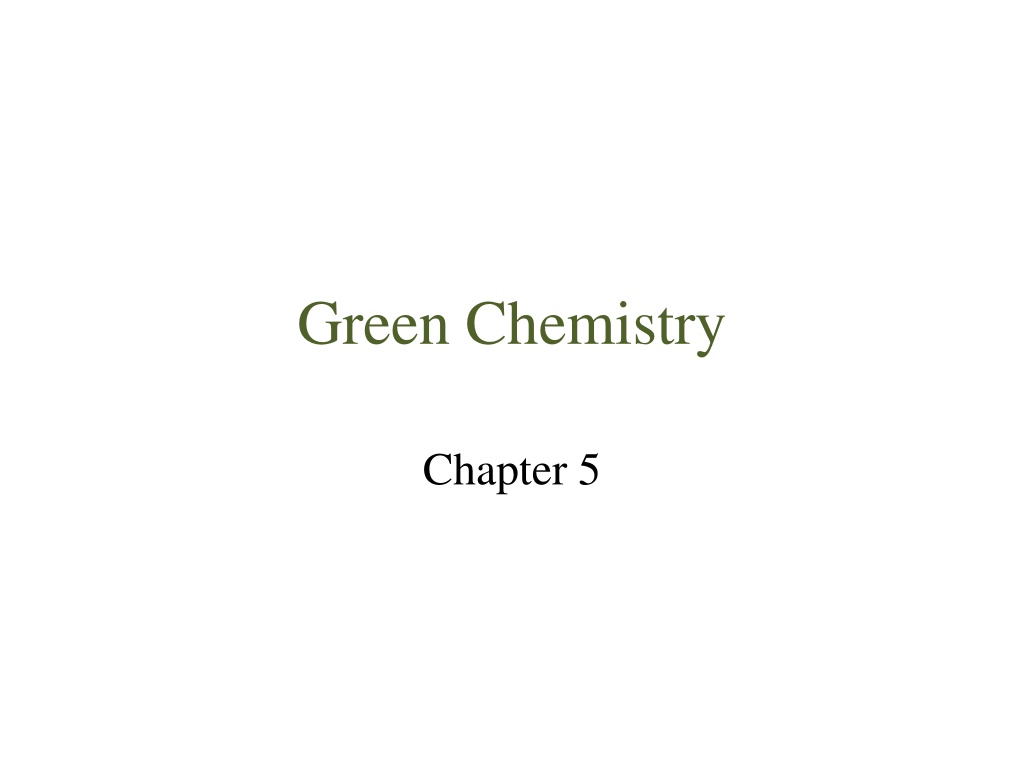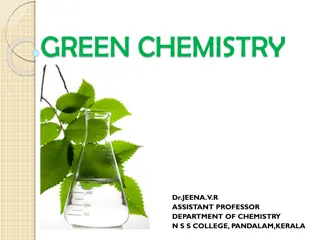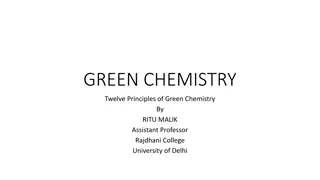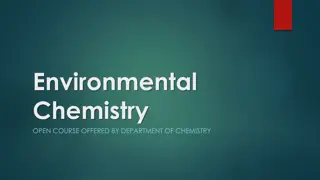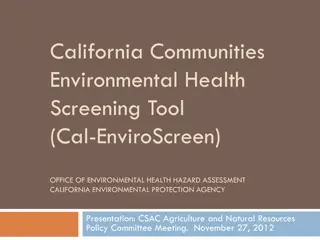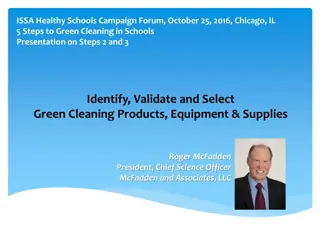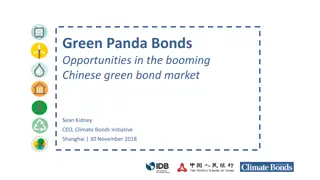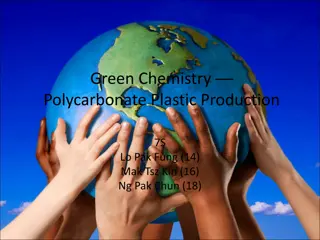Exploring Green Chemistry: Principles and Environmental Impacts
Understanding the principles of green chemistry, such as waste prevention and atomic economy, is crucial for designing chemical products that reduce environmental hazards. Environmental disasters like Love Canal and Cuyahoga River highlight the importance of sustainable practices in the chemical industry.
Download Presentation

Please find below an Image/Link to download the presentation.
The content on the website is provided AS IS for your information and personal use only. It may not be sold, licensed, or shared on other websites without obtaining consent from the author. Download presentation by click this link. If you encounter any issues during the download, it is possible that the publisher has removed the file from their server.
E N D
Presentation Transcript
Green Chemistry Chapter 5
DEFINITION OF GREEN OR SUSTAINABLE CHEMISTRY An approach to design, manufacture and use of chemical products to deliberately reduce or eliminate the chemical hazards and protect the environment.
Basic Principles of Green Chemistry 12 principles advocated by Dr. Paul Anastas and Dr. John Warner. 1. Prevention 2. Atomic Economy 3. Less Hazardous Chemical Synthesis 4. Designing Safer Chemicals 5. Safer Solvents and Auxiliaries 6. Design for energy efficiency
7. Use of Renewable Feedstocks 8. Reduce Derivatives 9. Catalysis 10. Design for Degradation 11. Real Time analysis for Pollution prevention 12. Essentially Safer Chemistry for Accident Prevention
1. Prevention It is better to prevent waste than to treat or clean up waste after created it. So, waste prevention is better than waste cleanup.
Environmental Disasters Love Canal In Niagara Falls, NY a chemical and plastics company had used an old canal bed as a chemical dump from 1930s to 1950s. The land was then used for a new school and housing track. The chemicals leaked through a clay cap that sealed the dump. It was contaminated with at least 82 chemicals (benzene, chlorinated hydrocarbons, dioxin). Health effects of the people living there included: high birth defect incidence and seizure-inducing nervous disease among the children.
Cuyahoga River Cleveland, Ohio There were many things being dumped in the river such as: gasoline, oil, paint, and metals. The river was called "a rainbow of many different colors". Some river! Chocolate-brown, oily, bubbling with subsurface gases, it oozes rather than flows. "Anyone who falls into the Cuyahoga does not drown," Cleveland's citizens joke grimly. "He decays." Time Magazine, August 1969 acc01
2. Atomic Economy Synthetic methods should be designed to maximize the incorporation of all materials used in the process into the final product.
Atom Economy Atom Economy % AE = (FW of atoms utilized/FW of all reactants) X 100 Balanced Equations Focuses on the reagents Stoichiometry? How efficient is the reaction in practice? Solvents? Energy?
Atom Economy Balanced chemical reaction of the epoxidation of styrene O O O O OH OH + + Cl Cl Assume 100% yield. 100% of the desired epoxide product is recovered. 100% formation of the co-product: m- chlorobenzoic acid A.E. of this reaction is 23%. 77% of the products are waste.
3. Less Hazardous Chemical Synthesis Synthetic routes should be designed in such a way that, it generates and uses substances that possess no or little toxicity to human health and the environment.
Preparation of acetanilide Conventional method: O O O Pyridine H2N N H O CH2Cl2 aniline acetic anhydride acetanilide Non-green components : CH2Cl2 , Pyridine Not atom economic : 1 mole of acetic acid unused. Green Procedure: O Zn dust H2N CH3COOH N H boil aniline acetanilide
Nitration of phenol Electrophilic Aromatic Substitution reaction Conventional procedure: OH O- O NaNO3 N+ HO N+ OH H2SO4 -O O phenol p-nitrophenol o-nitrophenol Non-green component Green Procedure: OH COOH OH COOH Ca(NO3)2 acetic acid NO2 salicylic acid 4-nitrosalicylic acid
Bromination of Acetanilide Conventional procedure: NHCOCH3 NHCOCH3 Br2 Glacial acetic acid Br Non-green component : Liquid molecular bromine Green Method Br NHCOCH3 O KBr Cerric ammonium nitrate N H H2O EtOH p-bromoacetanilide
4. Designing Safer Chemicals New chemical should be design with great effectiveness and new approaches to minimize the toxicity and harmless to the environment.
5. Safer Solvents and Auxiliaries The auxiliary substances (Inorganic and organic solvents) should be replaced by safer and eco- friendly green solvents like IL, supercritical CO2 fluid, and Supercritical water. Promote solvent free systems i.e adsorbents like clays, zeolites, silica, and alumina.
Safer solvents: Supercritical fluids A SCF is defined as a substance above its critical temperature (TC) and critical pressure (PC). The critical point represents the highest temperature and pressure at which the substance can exist as a vapor and liquid in equilibrium.
Ionic Liquids (Ils) Liquid at room temperature and below. Non-volatile Negligible vapour pressure Can be recycled High thermal stability to 200 oC or higher First Room temperature ionic liquid (RTIL) : Ethylammonium Nitrate [EtNH3 ]+[NO3]- was synthesized by Paul Walden (1914) using neutralization method.
Supercritical CO2 fluid Have low viscosity No surface tension Low toxicity Non-flammability Easily evaporated leaving no residue Can dissolve wide range of chemicals Used in fragrance compounds
Supercritical water Water become supercritical at 3740C and 218 atm. Use as a green solvent for many synthetic reactions.
6. Design for Energy Efficiency Energy requirements should be minimized. Process should be designed to occur at ambient conditions. Microwave irradiation, Sonication reaction or biological processes. - Microwave irradiation: Beckmann rearrangement of oximes without acid catalyst. -Sonochemistry (Ultrasound Energy): Ullmann s coupling.
7. Use of Renewable Feedstocks A raw material or feedstock should be renewable rather than depleting whenever technically and economically practical.
Biomaterials [Carbohydrates, Proteins, Lipids] Highly Functionalized Molecules Petroleum Products [Hydrocarbons] Singly Functionalized Compounds [Olefins, Alkylchlorides] Highly Functionalized Molecules
8. Reduce Derivatives Unnecessary derivatization (blocking group, protection/deprotection, temporary modification of physical/chemical processes) should be avoided whenever possible.
9. Catalysis Catalytic reagents (as selective as possible) are superior to stoichiometric reagents.
10. Design for Degradation Chemical products should be designed so that at the end of their function they do not persist in the environment and instead break down into innocuous degradation products.
Examples Chlorofluorocarbons (CFCs) Do not break down, persist in atmosphere and contribute to destruction of ozone layer DDT Bioaccumulate and cause thinning of egg shells
11. Real-time Analysis for Pollution Prevention Analytical methodologies need to be further developed to allow for real-time in-process monitoring and control prior to the formation of hazardous substances.
Real time analysis for a chemist is the process of checking the progress of chemical reactions as it happens. Knowing when your product is done can save a lot of waste, time and energy!
Analyzing a Reaction What do you need to know, how do you get this information and how long does it take to get it?
12. Inherently Safer Chemistry for Accident Prevention Substance and the form of a substance used in a chemical process should be chosen so as to minimize the potential for chemical accidents, including releases, explosions, and fires.
Cyanide! Phosgene!
Tragedy in Bhopal, India - 1984 What happened? Methyl isocyanate used to make pesticides was being stored in large quantities on-site at the plant Methyl isocyanate is highly reactive, exothermic molecule Most safety systems either failed or were inoperative Water was released into the tank holding the methyl isocyanate The reaction occurred and the methyl isocyanate rapidly boiled producing large quantities of toxic gas.
Conclusion Green chemistryNot a solution to all environmental problems But the most fundamental approach to preventing pollution.
